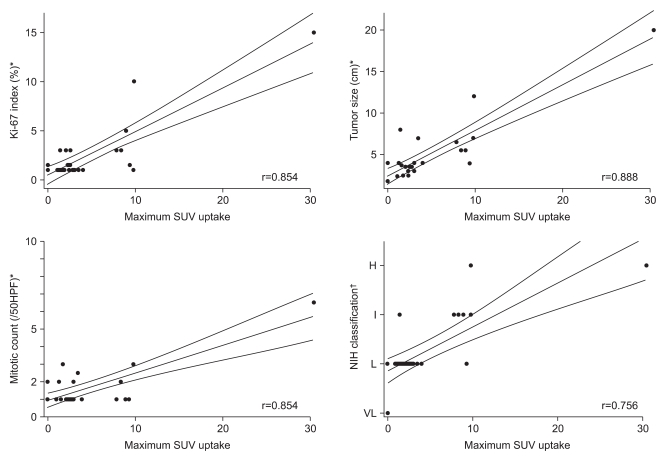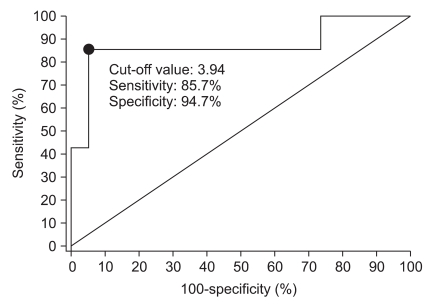J Gastric Cancer.
2011 Sep;11(3):173-179. 10.5230/jgc.2011.11.3.173.
Role of 18F-fluoro-2-deoxyglucose Positron Emission Tomography in Gastric GIST: Predicting Malignant Potential Pre-operatively
- Affiliations
-
- 1Department of Surgery, Catholic University of Daegu School of Medicine, Daegu, Korea. hdchae@cu.ac.kr
- 2Department of Pathology, Catholic University of Daegu School of Medicine, Daegu, Korea.
- 3Department of Nuclear Medicine, Catholic University of Daegu School of Medicine, Daegu, Korea.
- KMID: 2055515
- DOI: http://doi.org/10.5230/jgc.2011.11.3.173
Abstract
- PURPOSE
It is difficult to obtain biopsies from gastrointestinal stromal tumors (GISTs) prior to surgery because GISTs are submucoal tumors, despite being the most common nonepithelial neoplasms of the gastrointestinal tract. Unlike anatomic imaging techniques, PET-CT, which is a molecular imaging tool, can be a useful technique for assessing tumor activity and predicting the malignant potential of certain tumors. Thus, we aimed to evaluate the usefulness of PET-CT as a pre-operative prognostic factor for GISTs by analyzing the correlation between the existing post-operative prognostic factors and the maximum SUV uptake (SUVmax) of pre-operative 18F-fluoro-2-deoxyglucose (FDG) PET-CT.
MATERIALS AND METHODS
The study was conducted on 26 patients who were diagnosed with gastric GISTs and underwent surgery after being examined with pre-operative FDG PET-CT. An analysis of the correlation bewteen (i) NIH risk classfication and the Ki-67 proliferation index, which are post-operative prognostic factors, and (ii) the SUVmax of PET-CT, which is a pre-operative prognostic factor, was performed.
RESULTS
There were significant correlations between (i) SUVmax and (ii) Ki-67 index, tumor size, mitotic count, and NIH risk group (r=0.854, 0.888, 0.791, and 0.756, respectively). The optimal cut-off value for SUVmax was 3.94 between "low-risk malignancy" and "high-risk malignancy" groups. The sensitivity and specificity of SUVmax for predicting the risk of malignancy were 85.7% and 94.7%, respectively.
CONCLUSIONS
The SUVmax of PET-CT is associated with Ki-67 index, tumor size, mitotic count, and NIH classification. Therefore, it is believed that PET-CT is a relatively safe, non-invasive diagnostic tool for assessing malignant potential pre-operatively.
Keyword
MeSH Terms
Figure
Reference
-
1. Miettinen M, Majidi M, Lasota J. Pathology and diagnostic criteria of gastrointestinal stromal tumors (GISTs): a review. Eur J Cancer. 2002; 38(Suppl 5):S39–S51. PMID: 12528772.
Article2. Kindblom LG, Remotti HE, Aldenborg F, Meis-Kindblom JM. Gastrointestinal pacemaker cell tumor (GIPACT): gastrointestinal stromal tumors show phenotypic characteristics of the interstitial cells of Cajal. Am J Pathol. 1998; 152:1259–1269. PMID: 9588894.3. Miettinen M, Lasota J. Gastrointestinal stromal tumors--definition, clinical, histological, immunohistochemical, and molecular genetic features and differential diagnosis. Virchows Arch. 2001; 438:1–12. PMID: 11213830.4. Nakahara M, Isozaki K, Hirota S, Miyagawa J, Hase-Sawada N, Taniguchi M, et al. A novel gain-of-function mutation of c-kit gene in gastrointestinal stromal tumors. Gastroenterology. 1998; 115:1090–1095. PMID: 9797363.5. Taniguchi M, Nishida T, Hirota S, Isozaki K, Ito T, Nomura T, et al. Effect of c-kit mutation on prognosis of gastrointestinal stromal tumors. Cancer Res. 1999; 59:4297–4300. PMID: 10485475.6. Franquemont DW. Differentiation and risk assessment of gastrointestinal stromal tumors. Am J Clin Pathol. 1995; 103:41–47. PMID: 7817943.
Article7. Seidal T, Edvardsson H. Expression of c-kit (CD117) and Ki67 provides information about the possible cell of origin and clinical course of gastrointestinal stromal tumours. Histopathology. 1999; 34:416–424. PMID: 10231416.
Article8. Hasegawa T, Matsuno Y, Shimoda T, Hirohashi S. Gastrointestinal stromal tumor: consistent CD117 immunostaining for diagnosis, and prognostic classification based on tumor size and MIB-1 grade. Hum Pathol. 2002; 33:669–676. PMID: 12152168.
Article9. Amin MB, Ma CK, Linden MD, Kubus JJ, Zarbo RJ. Prognostic value of proliferating cell nuclear antigen index in gastric stromal tumors. Correlation with mitotic count and clinical outcome. Am J Clin Pathol. 1993; 100:428–432. PMID: 8105676.10. Fletcher CD, Berman JJ, Corless C, Gorstein F, Lasota J, Longley BJ, et al. Diagnosis of gastrointestinal stromal tumors: a consensus approach. Hum Pathol. 2002; 33:459–465. PMID: 12094370.
Article11. Saleem A, Charnley N, Price P. Clinical molecular imaging with positron emission tomography. Eur J Cancer. 2006; 42:1720–1727. PMID: 16797972.
Article12. Kamiyama Y, Aihara R, Nakabayashi T, Mochiki E, Asao T, Kuwano H, et al. 18F-fl uorodeoxyglucose positron emission tomography: useful technique for predicting malignant potential of gastrointestinal stromal tumors. World J Surg. 2005; 29:1429–1435. PMID: 16222452.13. Miettinen M, El-Rifai W, Sobin LH, Lasota J. Evaluation of malignancy and prognosis of gastrointestinal stromal tumors: a review. Hum Pathol. 2002; 33:478–483. PMID: 12094372.
Article14. Appelman HD. Mesenchymal tumors of the gut: historical perspectives, new approaches, new results, and does it make any difference? Monogr Pathol. 1990; (31):220–246. PMID: 2406575.15. Somerhausen Nde S, Fletcher CD. Gastrointestinal stromal tumours: an update. Sarcoma. 1998; 2:133–141. PMID: 18521245.
Article16. Ranchod M, Kempson RL. Smooth muscle tumors of the gastrointestinal tract and retroperitoneum: a pathologic analysis of 100 cases. Cancer. 1977; 39:255–262. PMID: 832238.17. Evans HL. Smooth muscle tumors of the gastrointestinal tract. A study of 56 cases followed for a minimum of 10 years. Cancer. 1985; 56:2242–2250. PMID: 4052969.
Article18. DeMatteo RP, Lewis JJ, Leung D, Mudan SS, Woodruff JM, Brennan MF. Two hundred gastrointestinal stromal tumors: recurrence patterns and prognostic factors for survival. Ann Surg. 2000; 231:51–58. PMID: 10636102.19. Demetri GD, von Mehren M, Blanke CD, Van den Abbeele AD, Eisenberg B, Roberts PJ, et al. Efficacy and safety of imatinib mesylate in advanced gastrointestinal stromal tumors. N Engl J Med. 2002; 347:472–480. PMID: 12181401.
Article20. Van den Abbeele AD, Badawi RD. Use of positron emission tomography in oncology and its potential role to assess response to imatinib mesylate therapy in gastrointestinal stromal tumors (GISTs). Eur J Cancer. 2002; 38(Suppl 5):S60–S65. PMID: 12528774.
Article21. Waseem NH, Lane DP. Monoclonal antibody analysis of the proliferating cell nuclear antigen (PCNA). Structural conservation and the detection of a nucleolar form. J Cell Sci. 1990; 96(Pt 1):121–129. PMID: 1695635.
Article22. Scholzen T, Gerdes J. The Ki-67 protein: from the known and the unknown. J Cell Physiol. 2000; 182:311–322. PMID: 10653597.
Article23. Brown DC, Gatter KC. Ki67 protein: the immaculate deception? Histopathology. 2002; 40:2–11. PMID: 11903593.
Article24. Cummings TJ, Provenzale JM, Hunter SB, Friedman AH, Klintworth GK, Bigner SH, et al. Gliomas of the optic nerve: histological, immunohistochemical (MIB-1 and p53), and MRI analysis. Acta Neuropathol. 2000; 99:563–570. PMID: 10805102.
Article25. Zlotta AR, Schulman CC. Biological markers in superficial bladder tumors and their prognostic significance. Urol Clin North Am. 2000; 27:179–189. PMID: 10696257.
Article26. Indinnimeo M, Cicchini C, Stazi A, Limiti MR, Ghini C, Mingazzini P, et al. Immunohistochemical assessment of Ki-67 as prognostic cellular proliferation marker in anal canal carcinoma. J Exp Clin Cancer Res. 2000; 19:471–475. PMID: 11277325.27. Yamada M, Niwa Y, Matsuura T, Miyahara R, Ohashi A, Maeda O, et al. Gastric GIST malignancy evaluated by 18FDG-PET as compared with EUS-FNA and endoscopic biopsy. Scand J Gastroenterol. 2007; 42:633–641. PMID: 17454885.28. Franquemont DW. Differentiation and risk assessment of gastrointestinal stromal tumors. Am J Clin Pathol. 1995; 103:41–47. PMID: 7817943.
Article29. Hirota S, Ohashi A, Nishida T, Isozaki K, Kinoshita K, Shinomura Y, et al. Gain-of-function mutations of platelet-derived growth factor receptor alpha gene in gastrointestinal stromal tumors. Gastroenterology. 2003; 125:660–667. PMID: 12949711.30. Schneider-Stock R, Boltze C, Lasota J, Peters B, Corless CL, Ruemmele P, et al. Loss of p16 protein defines high-risk patients with gastrointestinal stromal tumors: a tissue microarray study. Clin Cancer Res. 2005; 11(2 Pt 1):638–645. PMID: 15701851.
- Full Text Links
- Actions
-
Cited
- CITED
-
- Close
- Share
- Similar articles
-
- Role of 18F 2-fluoro-2-deoxyglucose Positron Emission Tomography in Upper Gastrointestinal Malignancies
- 18F-2-Deoxy-2-Fluoro-D-Glucose Positron Emission Tomography: Computed Tomography for Preoperative Staging in Gastric Cancer Patients
- Effectiveness of 18F-fluoro-deoxyglucose Positron Emission Tomography/Computed Tomography and Magnetic Resonance Imaging to Detect Iliopsoas Tendonitis after Total Hip Arthroplasty: A Case Report
- Positron Emission Tomography: Application in Pediatric Epilepsy
- Outcome in Patients with Fever of Unknown Origin whose ¹â¸Fluoro-Deoxyglucose Positron Emission Tomography/Computerized Tomography Finding is Non-Diagnostic



